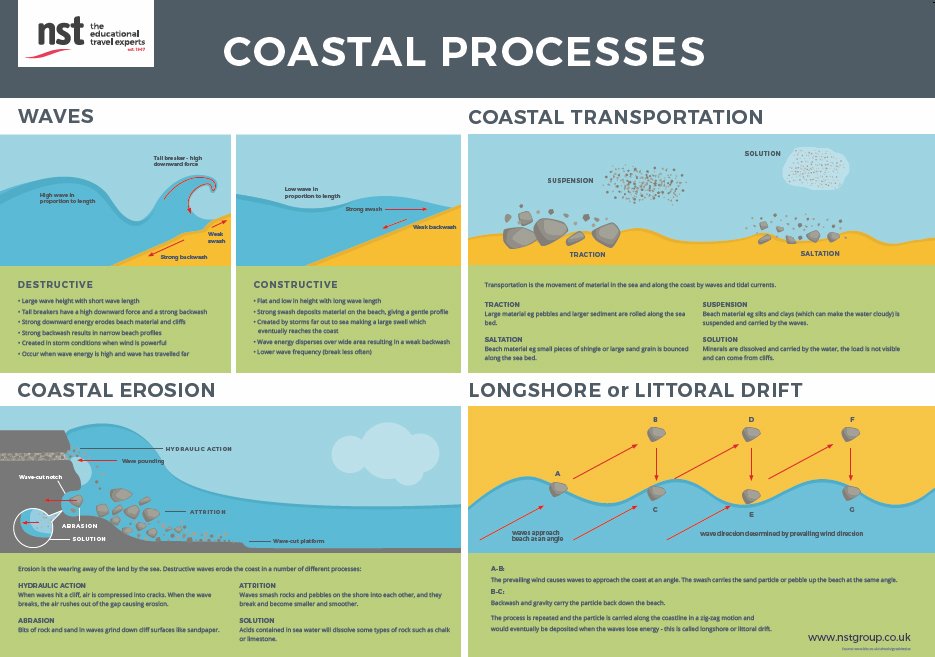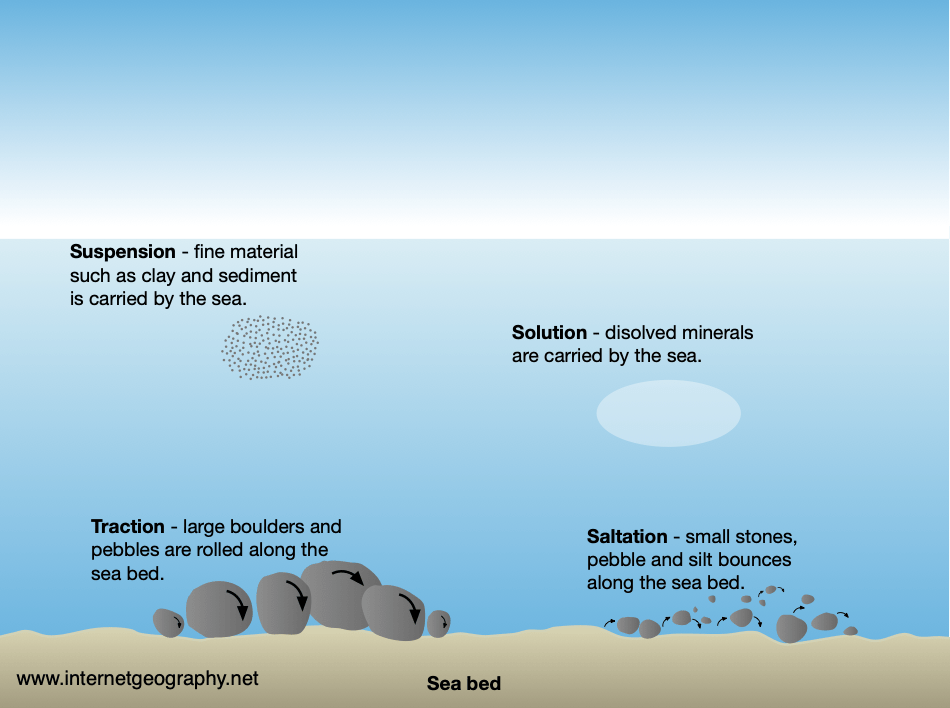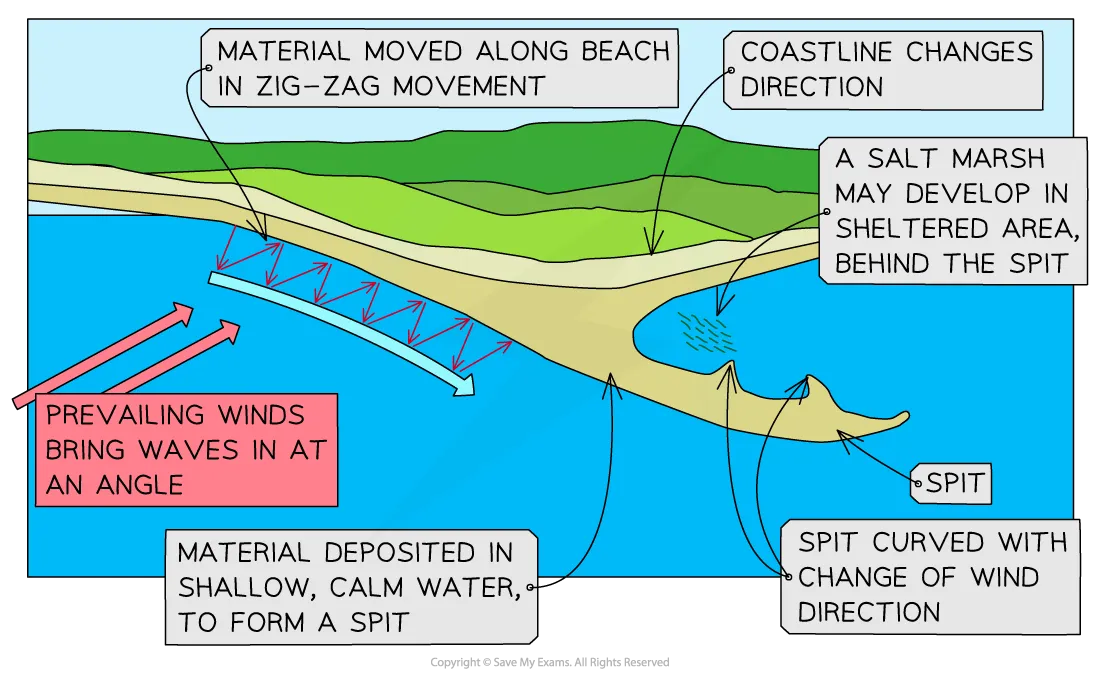
Introduction to Coastal Processes
Coastal processes are fundamental to understanding the dynamic and ever-changing nature of coastlines. These processes, primarily categorized as coastal erosion, deposition, and transportation, play a crucial role in shaping our shorelines. Each of these phenomena interacts continuously, leading to the formation and transformation of coastal landscapes.
Coastal erosion refers to the wearing away of land and the removal of beach or dune sediments by wave action, tidal currents, or wind. This process can lead to significant loss of land and alteration of coastal habitats. Understanding coastal erosion is vital as it directly affects coastal stability, human settlements, and marine ecosystems.
On the other side of the spectrum, coastal deposition involves the accumulation of sediments carried by wind, water, and ice. This process contributes to the creation of landforms such as beaches, spits, and sandbanks. Depositional features are essential for providing natural protection against coastal hazards and supporting diverse ecological communities.
Coastal transportation, the movement of sediments along the coast by wave action, is vital for the delivery and redistribution of these materials. Processes such as longshore drift facilitate the lateral movement of sand and pebbles, contributing to the continual reshaping of coastal environments. Efficient coastal transportation is crucial in maintaining the balance between erosion and deposition.
In the IGCSE Geography curriculum, the study of these coastal processes is not only essential but also interlinked with other geographical phenomena such as weathering, climate change, and human intervention. These interconnections highlight the complexity of coastal systems and the need for comprehensive understanding. Grasping the intricacies of coastal erosion, deposition, and transportation equips students with the knowledge to analyze coastal changes and predict future trends.
Recognizing the importance of these coastal processes helps in appreciating the dynamic nature of coastlines. It also underscores the need for sustainable management practices to mitigate adverse impacts and preserve coastal regions for future generations.

Types and Causes of Coastal Erosion
Coastal erosion represents the gradual removal of rock or soil along the coastline, a process driven by various natural and human factors. Understanding the distinct types of coastal erosion is essential for analyzing both past occurrences and predicting future impacts. The primary forms of coastal erosion include hydraulic action, abrasion, attrition, and solution.
Hydraulic action involves the power of wave force as water crashes against the coast, compressing air in cracks and forcing rock to break apart. Abrasion occurs when waves carrying materials such as sand, gravel, or pebbles grind against the shoreline, effectively wearing it down. Attrition refers to the process where the transported particles themselves collide with each other, becoming progressively smaller and rounder. Solution, or corrosion, is the chemical process where acidic waters dissolve rocks like limestone and chalk, progressively eroding the coastline.
The primary causes of coastal erosion are multifaceted. Natural factors like wave energy significantly contribute, where continual wave impacts erode the shoreline. Tidal patterns also play a crucial role, with high tides allowing waves to reach further inland. Weather conditions, such as storms and hurricanes, can accelerate erosion dramatically. Additionally, longshore drift, a process of sediment transportation, can redistribute material along the coast, reshaping it over time.
Human activities have exacerbated coastal erosion in many areas. Construction projects, such as the building of seawalls, jetties, and other coastal structures, can interfere with natural sediment movement, leading to increased erosion in adjacent areas. Moreover, pollution impacts coastal ecosystems, weakening vegetation that stabilizes the shoreline. Examples of areas severely affected by coastal erosion include the Holderness Coast in the United Kingdom and various Pacific Island nations, where the loss of land poses significant risks to human settlements and biodiversity.
The implications of coastal erosion are extensive, influencing both human and natural environments. The destruction of property, displacement of communities, loss of habitats, and changes in coastal landscapes necessitate comprehensive management strategies to mitigate and adapt to these ongoing challenges.
Processes and Features of Coastal Deposition
Coastal deposition occurs when the energy of the transporting medium, such as water or wind, decreases, allowing sediment to settle and accumulate. Key processes such as longshore drift and wave action play significant roles in this phenomenon. Longshore drift, driven by oblique wave angles, moves sediment along the coast, gradually depositing materials like sand and pebbles to form extensive and dynamic landforms.
Beaches represent one of the most common landforms created by coastal deposition. These depositional features are shaped by the sorting action of waves, which transport and deposit sediments of varying sizes along the shoreline. The material composition of beaches usually includes sand, gravel, and shingle. The size of the sediment further influences the beach’s slope and profile. For instance, beaches with larger particles like pebbles tend to have steeper gradients compared to sandy beaches.
Another prominent example of coastal deposition is the formation of spits. Spits are elongated landforms that extend from the coast into the ocean, often curving inward due to wave refraction. Spurn Head on the Humber Estuary in England serves as a classic instance of a spit formed by the interplay between longshore drift and prevailing wind direction.
Barrier islands, which run parallel to the coast, offer another significant example of depositional features. These islands typically form in regions with abundant sediment supply and moderate wave energy. Notable examples include the Outer Banks in North Carolina, USA, and the Wadden Islands in the Netherlands. These landforms provide essential protection to coastlines, acting as buffers against strong wave action and coastal storms.
In summary, the processes of coastal deposition, driven by mechanisms like longshore drift and wave action, result in the creation of varied and critical landforms such as beaches, spits, and barrier islands. Factors such as sediment size, type of material, and wave energy intricately influence the development and characteristics of these features, showcasing the complexity and dynamic nature of coastal environments worldwide.


Mechanisms of Coastal Transportation
Understanding the mechanisms of coastal transportation is pivotal in grasping how coastal landscapes are continuously altered. Coastal transportation involves the movement of sediment along the shoreline by natural agents, such as waves and currents. This process operates in concert with coastal erosion and coastal deposition, all contributing to the dynamic nature of coastal geography.
One of the principal mechanisms is longshore drift, a process driven by waves hitting the coast at an oblique angle. As waves approach at this angle, sediment is moved up the beach in the direction of the wave (swash), and then carried back down perpendicular to the shoreline by gravity (backwash). This zigzag pattern results in a net movement of material along the coast, which can lead to significant changes over time.
Saltation is another key transportation method where small pebbles and stones are bounced along the sea floor. This occurs primarily due to the force of the water lifting and dropping the particles. Larger particles often undergo traction, which is the rolling of larger stones and boulders along the seabed due to the force of moving water. Both processes ensure that even substantial sediment can be transported over long distances.
In contrast, finer sediment like silt and clay is typically carried in suspension, floating in the water column and traveling with the current. This suspended material can settle in quieter areas and contribute to coastal deposition. Additionally, some minerals dissolve in the water and are transported in solution, an invisible but effective form of sediment movement that can significantly alter the chemical composition of coastal waters.
These transportation processes do not work in isolation; they interact continuously with erosion and deposition. While erosion breaks down coastal material and makes it available for transport, deposition occurs when the transported sediment is laid down, reshaping features of the coastline such as beaches, spits, and bars. Understanding these intricate mechanisms provides a comprehensive insight into how our coastlines are formed and transformed.

Conclusion and Key Takeaways for IGCSE Students
Understanding coastal processes is essential for IGCSE Geography students as it provides a comprehensive insight into one of the most dynamic natural environments. Coastal erosion, deposition, and transportation are interconnected phenomena that shape the landscape and have profound implications for both the environment and human activities.
Coastal erosion involves the wearing away of land by the sea, impacting natural landscapes and human settlements. Key agents of erosion include waves, tides, and currents, which gradually break down rock formations and cliffs, leading to significant changes in coastal geography. Recognizing the factors that accelerate erosion, such as storm activity and human interference, is crucial for devising effective coastal management strategies.
In contrast, coastal deposition occurs when materials transported by the sea are deposited on the shore, leading to the formation of features such as beaches, spits, and sandbars. This process is integral to the creation and maintenance of these landscapes, underscoring the natural balance between erosion and deposition. Understanding how deposition works helps students appreciate the measures needed to protect and sustain these vital coastal features.
Coastal transportation refers to the movement of sediments along the coast by waves and currents. This process plays a pivotal role in shaping coastal areas by redistributing eroded materials and facilitating deposition in different locations. Longshore drift is a key mechanism of coastal transportation, influencing the formation and evolution of beaches and other coastal formations.
The study of these coastal processes extends beyond academic knowledge; it is vital for effective environmental management and conservation. Students should explore resources such as geography textbooks, academic journals, and interactive online platforms to deepen their understanding. Participating in field studies and observing real-world coastal phenomena can also provide invaluable practical insights.
By mastering the concepts of coastal erosion, deposition, and transportation, IGCSE students will be better equipped to understand the complexities of coastal environments and contribute to sustainable coastal management practices.




